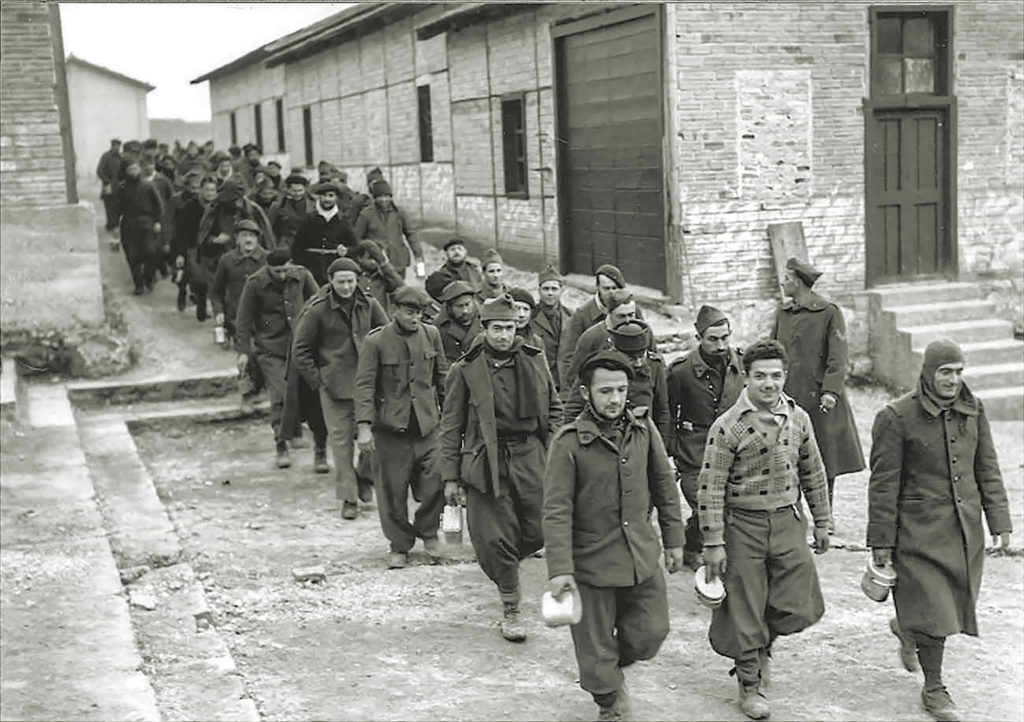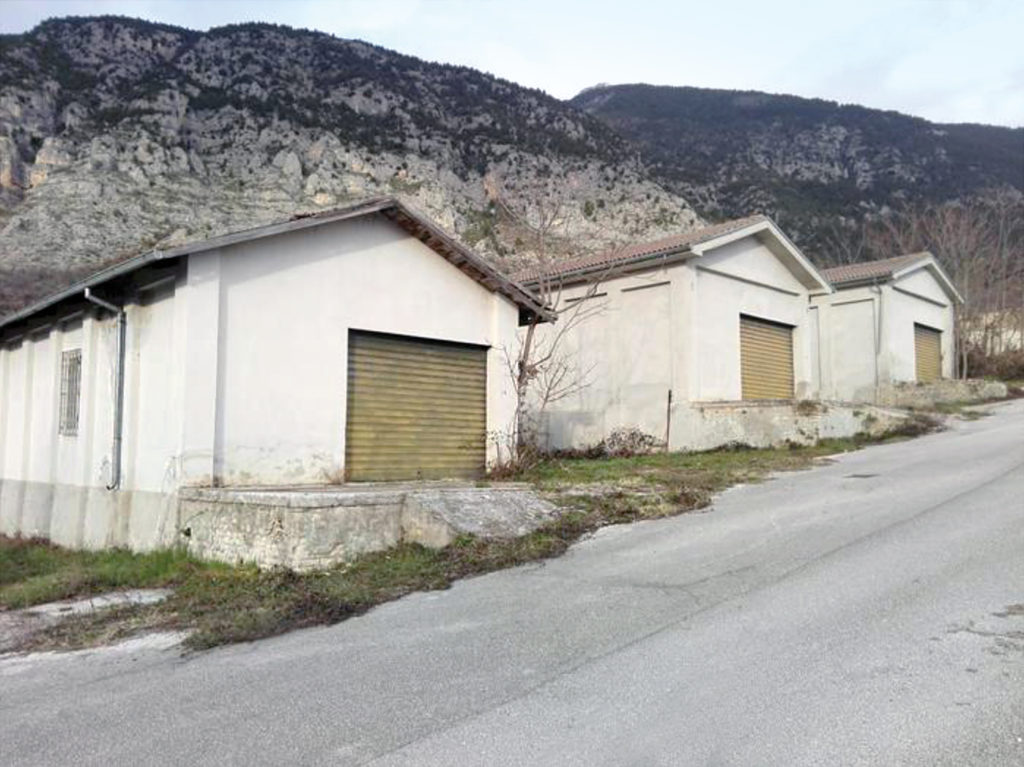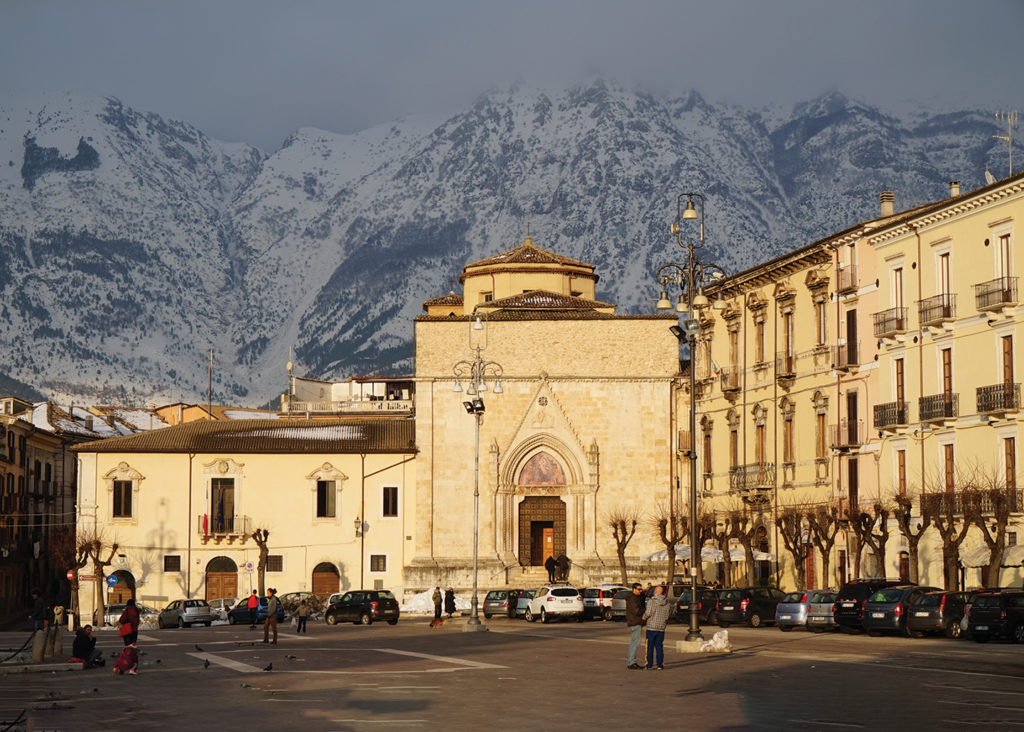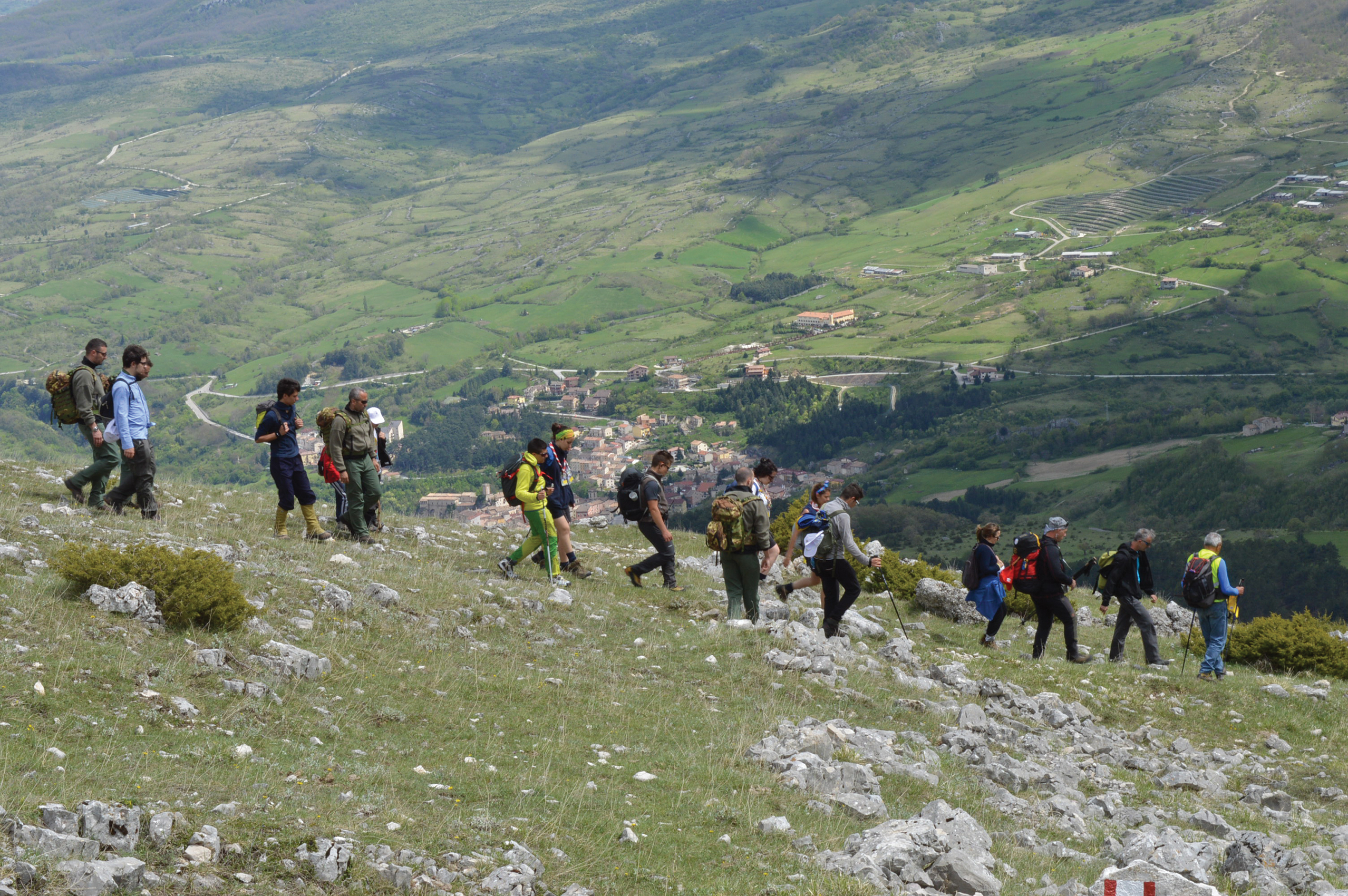A scenic hiking trail in central Italy once served as a route for prisoners fleeing a notorious war camp.
Climbing a steep slope a few miles outside the central Italian city of Sulmona, I come across a wooden bench grafted invitingly into the hillside and sit down to study the view. To the northeast lie Abruzzo’s smooth-topped Morrone Mountains, dotted with medieval hermitages and ancient beech forests. To the east and partially obscured are the taller, craggier peaks of the Majella range. Beneath me, in the Peligna Valley, lies the compact city of Sulmona with its 12th-century aqueduct and, if I look closely enough, something more sinister: an infamous prisoner of war camp known as Campo 78.
Nearly 80 years ago, during the winter of 1943-44, passing travelers would not have wanted to sit on this solitary bench and admire the view. Danger lurked all around. The steep, narrow path I’m following—which starts just outside Sulmona and winds precipitously across the Apennines for nearly 40 miles—was not a hiking trail but an escape route for Allied prisoners trying to outrun and outwit the German army.
On September 8, 1943, the prisoners at Campo 78 in the village of Fonte d’Amore, three miles north of Sulmona, awoke to discover that their Italian guards had deserted their posts. With the Allied armies invading Italy from the south, the Italian government had ignominiously surrendered. Anxious to derail a swift Anglo-American advance, the Germans promptly activated Fall Achse (Case Axis), disarming the Italian forces and taking over the defense of the country themselves. However, during the transition, confusion reigned. Taking advantage of the uncertainty, around two-thirds of the 3,000 POWs in Campo 78—mostly British and Commonwealth soldiers from the North African campaign—decided to flee before the Germans arrived. Breaking through the perimeter wire, they ran haphazardly into the surrounding mountains, where they hid in caves, mineshafts, and old barracks. By lying low, they reasoned it wouldn’t be long before they could head south and reconnect with the advancing British and American armies.


A day earlier, I had wandered north out of Sulmona to see what is left of the prison. From a quiet, rural lane on the edge of Fonte d’Amore, I am surprised to see that much of the camp remains intact. Viewed from the road, its high barbed-wire fence and cylindrical watchtowers set a menacing tone. The eeriness continues inside as I walk through overgrown grass and invasive weeds past two rows of simple brick huts, each once home to around 50 prisoners. While devoid of furnishings, these spartan barracks contain something more poignant. On the dirty white walls, the prisoners had etched their names, scribbled playful military doodles, and drawn insignia of their regiments, including the “York and Lancaster” and the “Royal Hussars.”
The Germans arrived in Sulmona on September 14, 1943. Better armed and organized than their Italian counterparts, they proceeded to round up more than three-quarters of the camp’s escaped prisoners, capturing many of them in the surrounding countryside before transporting them north to POW camps in Germany. To counter an Allied advance into Italy’s industrial heartland, the Germans set up fortifications across the Apennine Mountains. Over the ensuing months, defenses embedded along the so-called Gustav Line just south of Sulmona successfully stalled the Allies until June 1944 and created a formidable barrier for desperate Campo 78 escapees still hiding in the high country.
Back on the hillside, I abandon the bench and head east toward the imposing Majella Mountains. These days, this hiking trail is known as the Sentiero della Libert˝a, or Freedom Trail. Marked with wooden information boards and stone memorials, the trail was laid out by a local cultural association in the early 2000s in remembrance of the prisoners and partisans who used this and other paths during the war.
In the fall of 1943, as the weather grew colder and news filtered through that the Allies had taken the town of Casoli on the banks of the Sangro River, surviving Campo 78 escapees who had so far eluded Nazi roundups plotted to break out of German-held territory and reclaim their liberty. Casoli was around 40 miles east of Sulmona, a treacherous journey across the Majella Mountains through backcountry regularly patrolled by German troops. The POWs split themselves into small groups and opted to hide by day and, often disguised as local shepherds, trek by night. With the help of Abruzzi villagers who risked being shot if they were caught, they subsisted on sheep’s milk, leftover food scraps, and Red Cross parcels they’d taken from the camp before they left. Different groups took different routes. Two Canadian airmen named Raymond Sherk and Don McLarty spent three weeks sheltering in a cave near the village of Roccacasale, eight miles north of Sulmona. They were aided by a local woman named Maria Carbone and ultimately made it across the Gustav Line in November 1943, eight weeks after their initial escape. Others weren’t so lucky, having to wait until the following February, March, or even later until they reached safety.

Today’s 37-mile-long trail, which tracks one of the more direct escape routes, is maintained by the Majella National Park and marked with signposts emblazoned with the letter “L” for “libert˝a” (freedom). Beyond my restful bench, the path ascends and descends across scrubby hillsides and walled pastures, dipping in and out of beech groves and crossing grassy meadows punctuated with the occasional gurgling spring. I imagine the fear and trepidation of fleeing fugitives as I pass under a brick railway arch and circumnavigate the hushed village of Cansano on quiet backroads. In the shifting alliances of wartime Italy, it became increasingly difficult to decipher friend from foe, partisan from fascist.
On the edge of the large village of Campo di Giove, 13 miles southeast of Sulmona, a plaque acknowledges the escape of Carlo Azeglio Ciampi, a second lieutenant in the Italian army who tackled the trail during a blizzard in March 1944 on his way to join the Italian Resistance in Bari, nearly 200 miles away. Ciampi went on to become his country’s prime minister in 1993-94 and its president from 1999 to 2006. In May 2001, at the age of 80, he inaugurated an annual commemorative march along the Freedom Trail, an event that today attracts more than 500 people who split the trek between Sulmona and Casoli over three days.
From Campo di Giove, I ascend the rocky Majella toward Guado di Coccia, the path’s highest point at 5,500 feet. Atop a barren mountain pass, now home to a ski lift and a public mountain refuge, another memorial marks the spot where a defecting Italian lieutenant named Ettore di Corti was shot by the Germans in October 1943 when the group of 20 Italian partisans he was escorting ran into a Wehrmacht patrol.
From the Guado, where views open out east toward the Adriatic, fugitives could practically sniff freedom. By early 1944, the British Eighth Army had crossed the Sangro River and were operating out of headquarters in Casoli under the command of a British officer named Lionel Wigram. In a military marriage of convenience, Wigram enlisted volunteer Italian partisans from the newly formed Majella Brigade to fight alongside the Eighth Army. With their detailed knowledge of the local terrain, Brigade volunteers often operated behind German lines and were key in aiding and abetting runaway Allied soldiers to navigate their way out of German-held territory.
Bruised clouds are amassing as I climb over the Guado di Coccia with nearly 20 miles wearing on my legs. I spot the clustered rooftops of the village of Palena on the other side. There is little cover on this exposed hilltop; I try to capture the unease and paranoia that would have gripped escapees who had made it this far. I zigzag down the mountainside, paralleling a stream and passing a small ruined chapel. With no Germans to evade, my freedom trail ends here, at Palena. It’s been a long, hilly hike since Sulmona, and the light is beginning to fade. Unlike the erstwhile escapees, I have the luxury of spending the night in a small village guesthouse. In the morning, I’ll take a bus and a train back to Sulmona. The final 17-mile stretch of the Sentiero della Libert˝a, from Palena to Casoli, can wait for another day.
Of the 2,000 or so inmates who fled Campo 78, an estimated 200 ultimately breached the Gustav Line and rejoined the Allies, making it one of the most successful prison breakouts of World War II. The remaining POWs were mostly reimprisoned by the Germans; mercifully, few lost their lives. The Gustav Line held firm until late spring 1944, when repeated assaults from Allied troops around Monte Cassino finally punched a significant hole in the German defenses. Sulmona was liberated in June, and the Allies finally pushed north toward Tuscany and, ultimately, Lombardy and Piedmont.
Nowadays, Sulmona remains a quiet Abruzzo town. Famous for being the birthplace of the Roman poet Ovid, it shows few visible signs of the war. The surrounding mountains are protected in the Majella National Park—their slopes largely peaceful, but their trails colored with the heroic stories of a tumultuous past. ✯
WHEN YOU GO
Sulmona is two and a half hours from Rome by frequent daily trains. Winter snow in the Apennine Mountains can be heavy, making May to October the best season for hiking. Campo 78 remains largely intact; visits to the brick barracks can be made by appointment through the local tourist office (email: unafondazioneperilmorrone@gmail.com). Give at least two weeks’ notice. There are plans to make the camp into a memorial park.
Where to Stay and Eat
Albergo Stella is a congenial, family-run hotel with an attached café in the historic center of Sulmona. The city’s restaurants offer some fine examples of Abruzzo cuisine, such as chitarra (Abruzzo-style spaghetti) and arrosticini (barbecued lamb skewers). Try Il Vecchio Muro, with its pleasant garden and cavernous interior, or La Cantina di Biffi, set in a handsome stone-walled cantina, or wine cellar.
What Else to See and Do
Sulmona’s Gothic-meets-baroque Cathedral of San Panfilo protects the relics of the famous hermit pope Celestine V. While strolling the compact historic center, look out for the 12th-century Gothic aqueduct and a classical statue of the Roman poet Ovid. It’s worth taking a 25-minute bus ride to the spectacularly sited village of Pacentro, where the Majella National Park office dispenses trail information. ✯
This article was published in the December 2020 issue of World War II.





